Irena Sendler Worksheets
Do you want to save dozens of hours in time? Get your evenings and weekends back? Be able to teach about Irena Sendler to your students?
Our worksheet bundle includes a fact file and printable worksheets and student activities. Perfect for both the classroom and homeschooling!
Resource Examples
Click any of the example images below to view a larger version.
Fact File
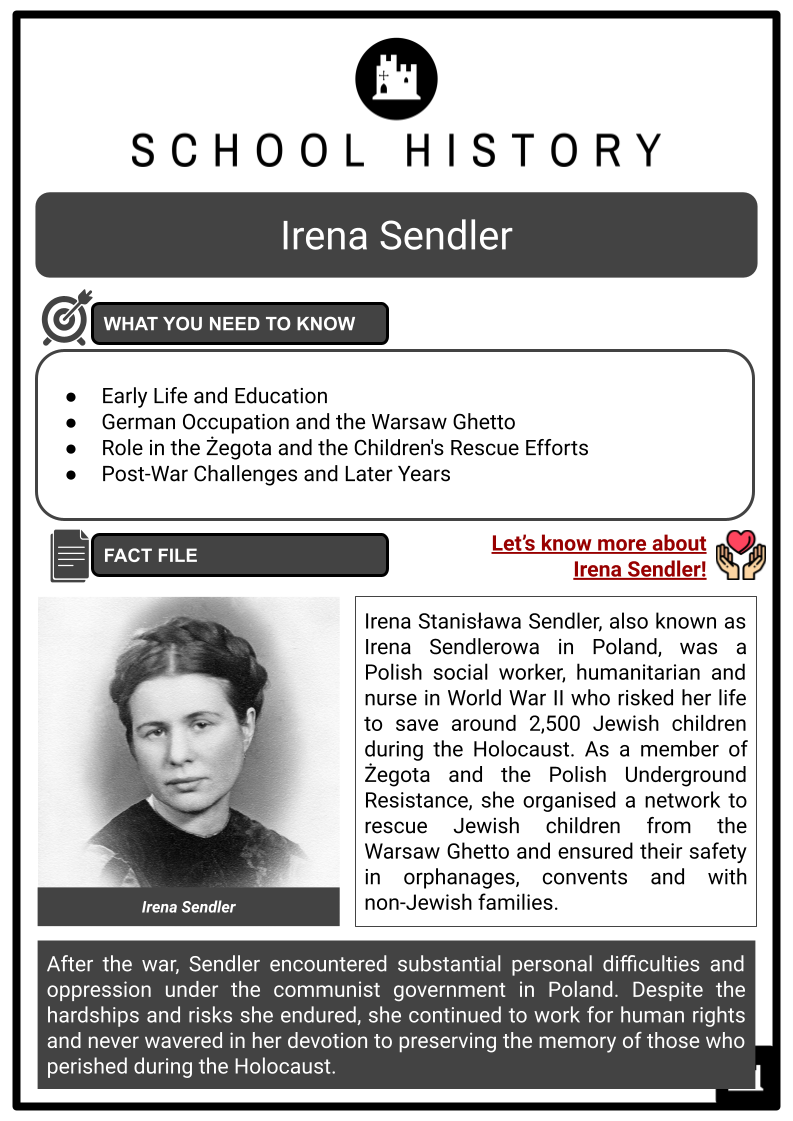
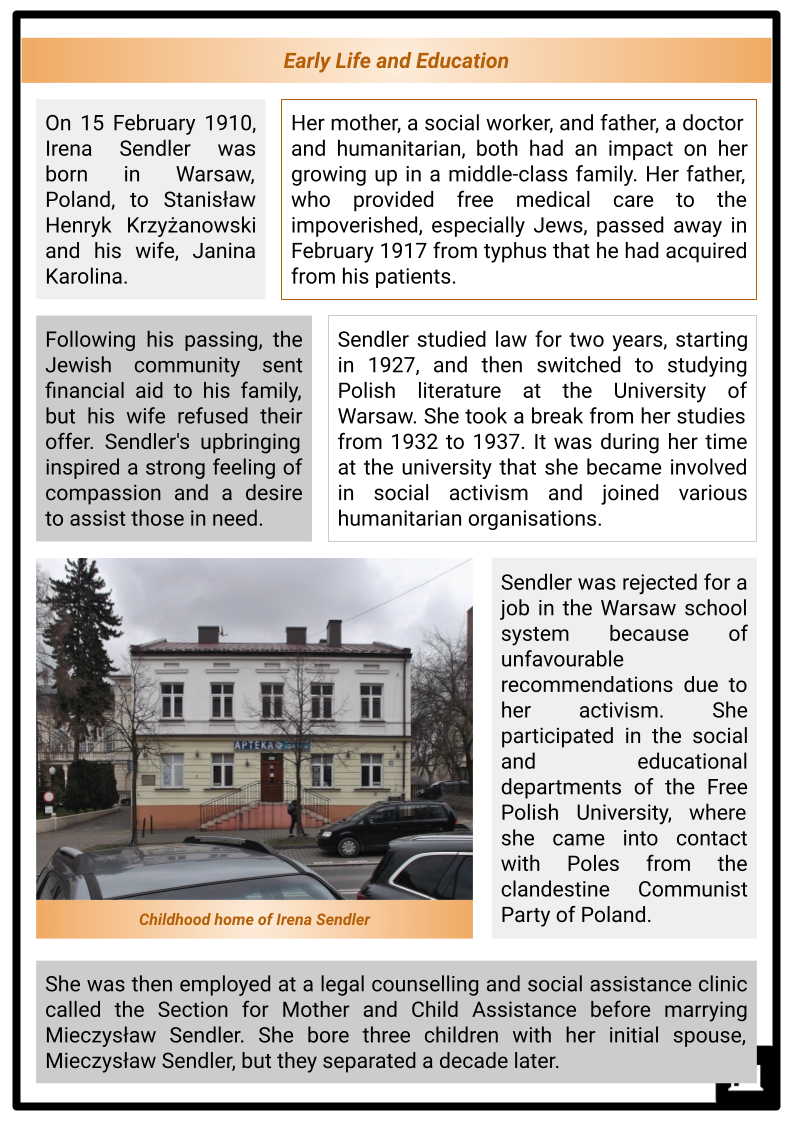
Student Activities
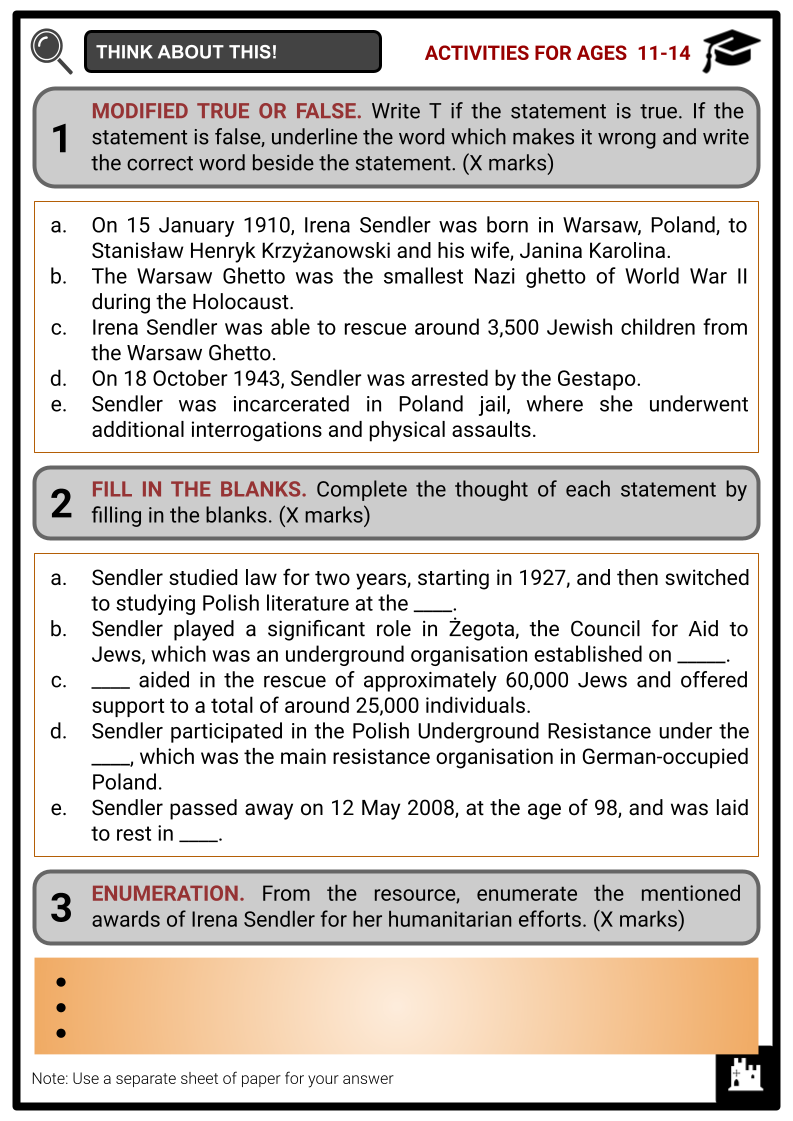
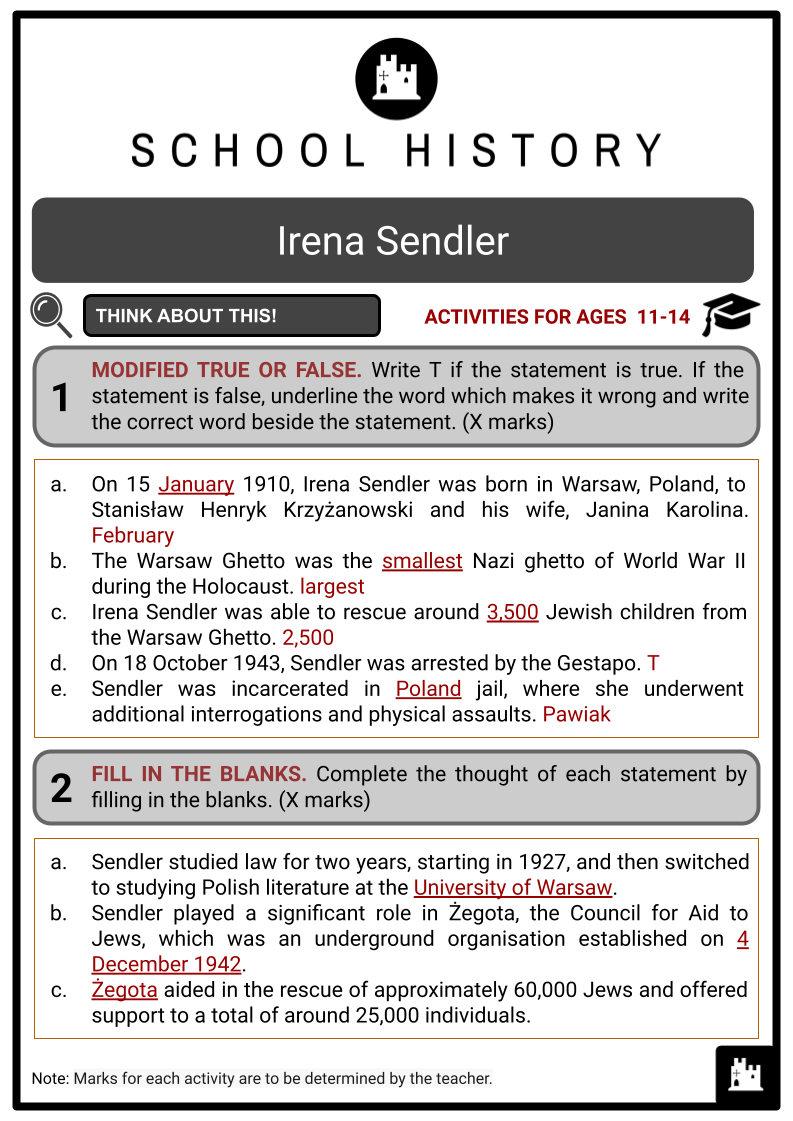
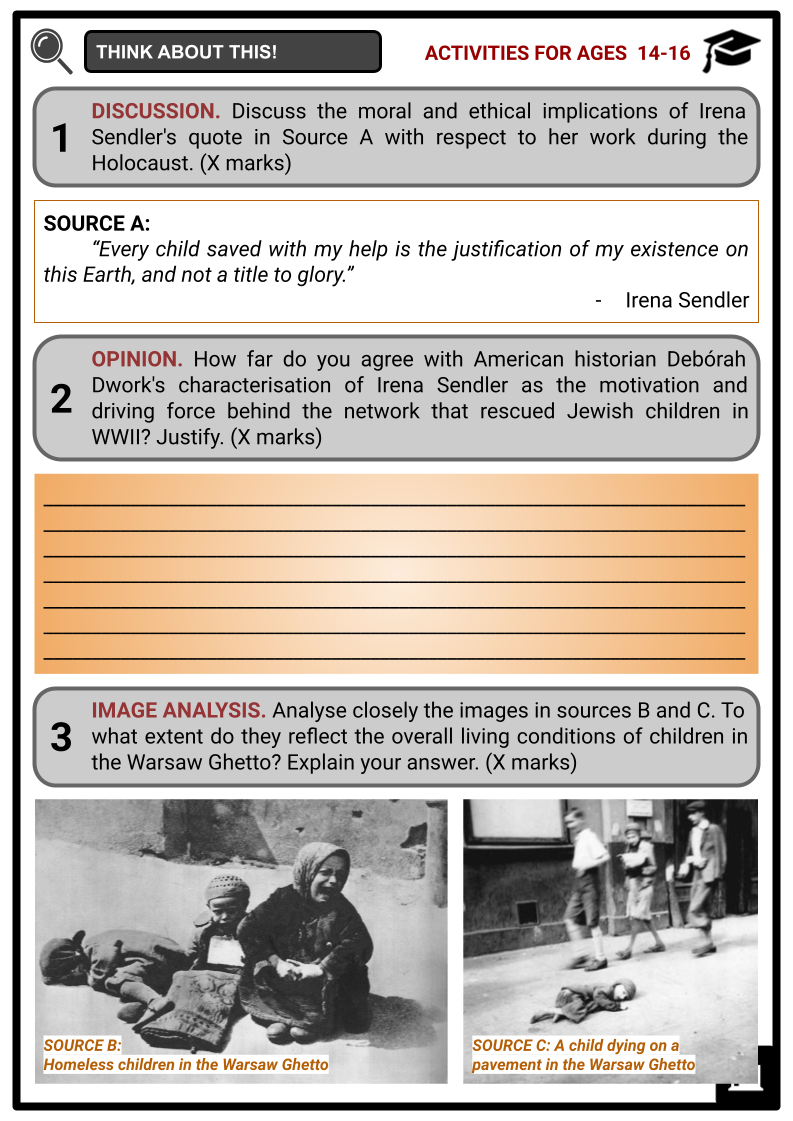
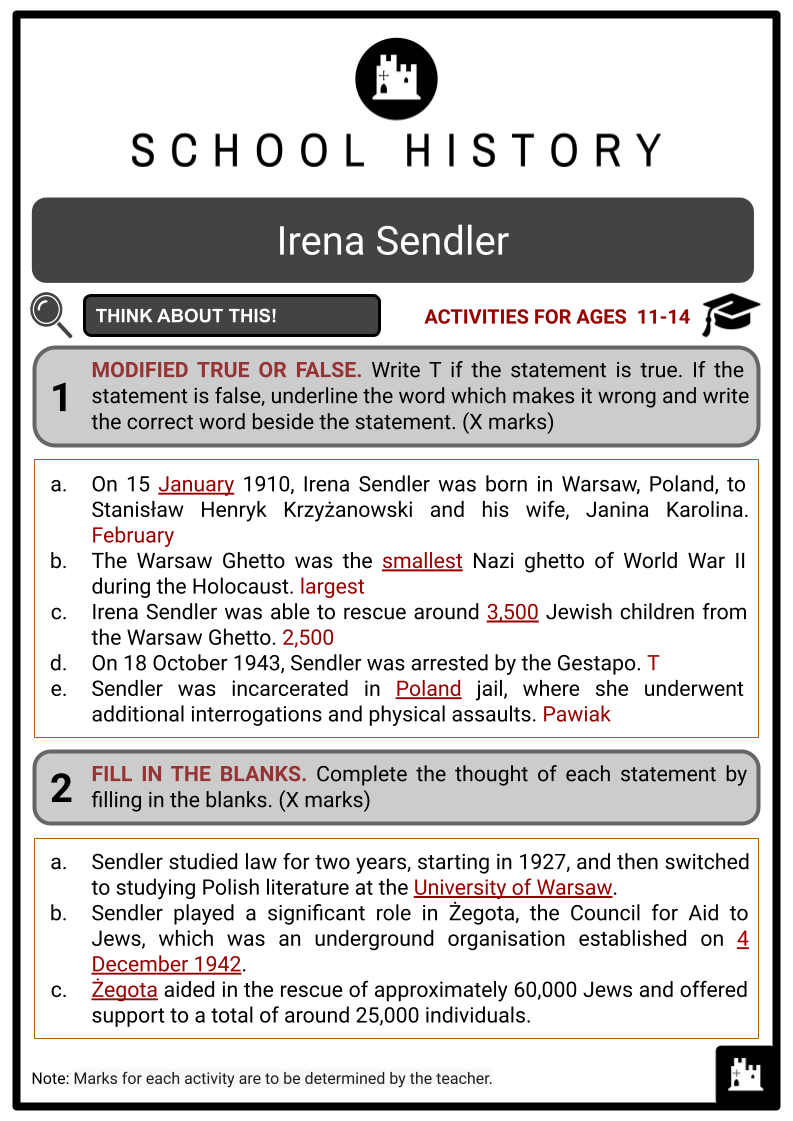
Summary
- Early Life and Education
- German Occupation and the Warsaw Ghetto
- Role in the Żegota and the Children's Rescue Efforts
- Post-War Challenges and Later Years
Key Facts And Information
Let’s know more about Irena Sendler!
Irena Stanisława Sendler, also known as Irena Sendlerowa in Poland, was a Polish social worker, humanitarian and nurse in World War II who risked her life to save around 2,500 Jewish children during the Holocaust. As a member of Żegota and the Polish Underground Resistance, she organised a network to rescue Jewish children from the Warsaw Ghetto and ensured their safety in orphanages, convents and with non-Jewish families. After the war, Sendler encountered substantial personal difficulties and oppression under the communist government in Poland. Despite the hardships and risks she endured, she continued to work for human rights and never wavered in her devotion to preserving the memory of those who perished during the Holocaust.
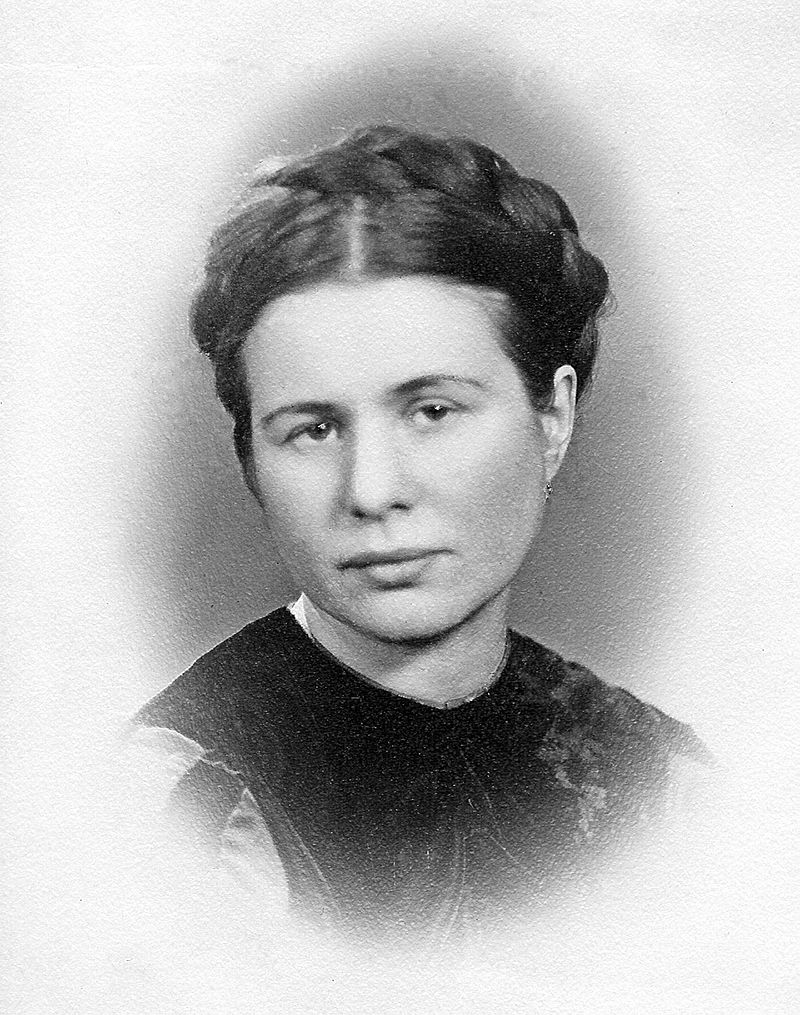
Early Life and Education
- On 15 February 1910, Irena Sendler was born in Warsaw, Poland, to Stanisław Henryk Krzyżanowski and his wife, Janina Karolina.
- Her mother, a social worker, and father, a doctor and humanitarian, both had an impact on her growing up in a middle-class family. Her father, who provided free medical care to the impoverished, especially Jews, passed away in February 1917 from typhus that he had acquired from his patients.
- Following his passing, the Jewish community sent financial aid to his family, but his wife refused their offer. Sendler's upbringing inspired a strong feeling of compassion and a desire to assist those in need.
- Sendler studied law for two years, starting in 1927, and then switched to studying Polish literature at the University of Warsaw. She took a break from her studies from 1932 to 1937. It was during her time at the university that she became involved in social activism and joined various humanitarian organisations.
- Sendler was rejected for a job in the Warsaw school system because of unfavourable recommendations due to her activism. She participated in the social and educational departments of the Free Polish University, where she came into contact with Poles from the clandestine Communist Party of Poland.
- She was then employed at a legal counselling and social assistance clinic called the Section for Mother and Child Assistance before marrying Mieczysław Sendler. She bore three children with her initial spouse, Mieczysław Sendler, but they separated a decade later.
German Occupation and the Warsaw Ghetto
- The German occupation of Poland began on 1 September 1939, when the country was invaded by both Nazi Germany and the Soviet Union. The invasion resulted in a harsh occupation that had a severe impact on the Polish populace, especially the Jewish community.
- One of the most tragic consequences of the German occupation was the establishment of the Warsaw Ghetto. It was the largest Nazi ghetto of World War II during the Holocaust. The German authorities built it in November 1940 in the new General Government region of occupied Poland.
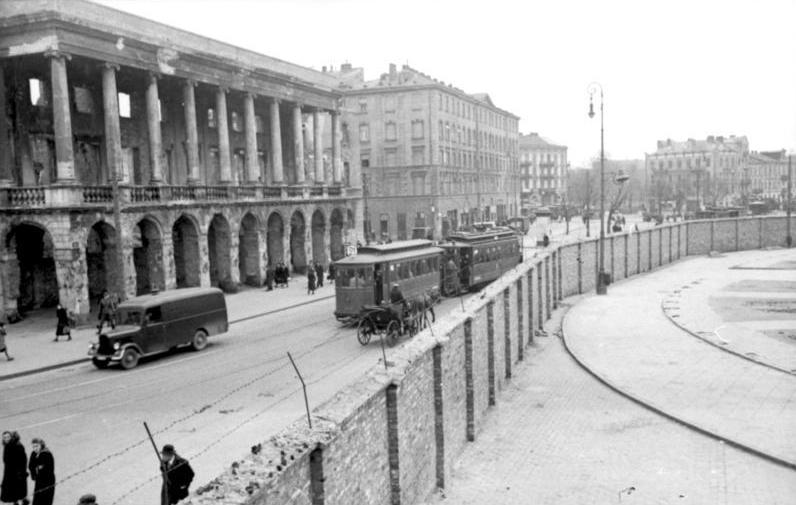
- At its peak, 460,000 Jews were imprisoned in a 1.3-square-mile area with 9.2 people per chamber. Warsaw Ghetto Jews were transferred to Nazi concentration camps and mass-killing centres.
- The Nazis restricted food and medicine to starve and infect the ghetto. Jewish Warsaw residents received 184 calories per day in 1941, compared to 699 for gentile Poles and 2,613 for Germans. Rations dropped to 177 calories per person in August. The German authorities provided dry bread, flour, low-quality potatoes, groats, turnips, and a little monthly addition of margarine, sugar and pork.
- Men, women and children smuggled and traded illegally, while private workshops made things to sell discreetly on the 'Aryan' side of the city. Children alone snuck food across the ghetto wall by the hundreds, often multiple times a day, returning with goods as heavy as they were. Smuggling was often the only way to survive in the ghetto, where unemployment and extreme poverty caused famine.
- In the first year and a half, hundreds of Polish Jews and some Romani from smaller cities and the countryside were placed into the ghetto, although many perished from typhus and malnutrition, keeping the population steady.
- Sendler, deeply affected by the suffering of the Jewish community, became increasingly involved in efforts to help those trapped in the Warsaw Ghetto. As a member of the Social Welfare Department, Sendler was granted special permits to enter the ghetto to check for typhus, which the Germans feared would spread. They transported drugs, hygiene products, clothing, food and other supplies into the ghetto under the guise of sanitary inspections.
- Sendler was inspired to expand the ghetto assistance operation by her friends, acquaintances and former co-workers who ended up on the Jewish side of the wall. Sendler and other social workers helped Jews escape or smuggled infants and small children out of the ghetto.
- In the summer of 1942, evacuating Jews and helping them survive became a priority. This work was extremely dangerous at the time because, since October 1941, helping Jews in German-occupied Poland constituted a capital offence for the helper and their family. Nonetheless, although Sendler's life was often at risk, she continued her efforts to save as many lives as possible.
Role in the Żegota and the Children's Rescue Efforts
- Sendler played a significant role in Żegota, the Council for Aid to Jews, which was an underground organisation established on 4 December 1942, formed to rescue Jews in Poland during World War II. It was the continuation of an earlier assistance organisation, the Provisional Committee to Aid Jews, that was founded on 27 September 1942, by Polish Catholic activists Zofia Kossak-Szczucka and Wanda Krahelska-Filipowicz.
- Żegota, consisting of members from various political and social backgrounds, offered food, medical assistance and financial support, and forged identification papers to numerous Polish Jews who were hiding within the German-occupied territory. It had approximately one hundred cells and collaborated with the Home Army to create forged documents. It aided in the rescue of approximately 60,000 Jews and offered support to a total of around 25,000 individuals.
- Sendler worked as a coordinator for the Welfare Department network in Żegota from January 1943 onwards. They allocated financial grants provided by the organisation. Consistent payments, however inadequate, improved their capacity to support the Jews in hiding.
- Aleksandra Dargiel, a manager at the Central Welfare Council (RGO), established a children's division for Żegota in August 1943. In September, Dargiel resigned because she was feeling overburdened with her RGO duties and suggested Sendler as her replacement. Sendler assumed control of the children's division in October 1943.
- Sendler used her contacts and resources to facilitate the rescue and relocation of Jewish children from the Warsaw Ghetto. She led a network of social workers, church members and local families in the rescue of Jewish children from the ghetto.
- Sendler and her colleagues did everything they could to get the children out of the ghetto. They often hid them in Polish homes, convents and schools. Every child was given a new name and put in homes where they would be safe from the horrors of the Holocaust. They concealed lists of the undisclosed children in jars to monitor their true and altered identities. The goal was to reunite the children with their biological relatives, if they were still alive following the war.
- During WWII, Sendler participated in the Polish Underground Resistance under the Home Army, which was the main resistance organisation in German-occupied Poland.
- The resistance significantly impeded German supply routes to the Eastern Front by damaging 1/8 of all rail cargo. They also supplied British intelligence agencies with 43% of all reports from occupied Europe.
- Sendler collaborated with the Polish underground to coordinate and execute various operations aimed at rescuing Jewish children and families from the Warsaw Ghetto. Secret codes, safe houses and forged documents were just a few of the clandestine methods employed by Sendler and her collaborators to ensure the safety of the rescued children. Each operation required meticulous planning and precision to evade detection by the occupying forces.
- American historian Debórah Dwork stated that Sendler was the motivation and driving force behind the entire network that rescued Jewish children. She was able to rescue around 2,500 Jewish children from the Warsaw Ghetto.
- On 18 October 1943, Sendler was arrested by the Gestapo (official secret police of Nazi Germany) for hiding the names of the Jewish children with her companion, Janina Grabowska. If the Gestapo were to obtain this knowledge, all children would be at risk, yet Grabowska was never investigated. Even after suffering horrific abuse at the hands of the Gestapo, Sendler did not desert her friends or the kidnapped children.
- She was incarcerated in Pawiak jail, where she underwent additional interrogations and physical assaults. On 13 November, she was transferred to a different site for execution by firing squad. She was saved from death when the German guards carrying her accepted a bribe and freed her before reaching the execution site.
- Sendler was released with the help of Maria Palester, a colleague from the Welfare Department, who secured the required sums from Żegota leader Julian Grobelny for a bribe.
- After her release, Sendler decided to stay concealed under the identity of Klara Dąbrowska, a nurse. She resumed her role as manager of the children's division at Żegota in December 1943. She served as a nurse at a field hospital during the Warsaw Uprising, when several Jews were concealed. She worked as a nurse until the Germans departed Warsaw, withdrawing in the face of advancing Soviet forces.
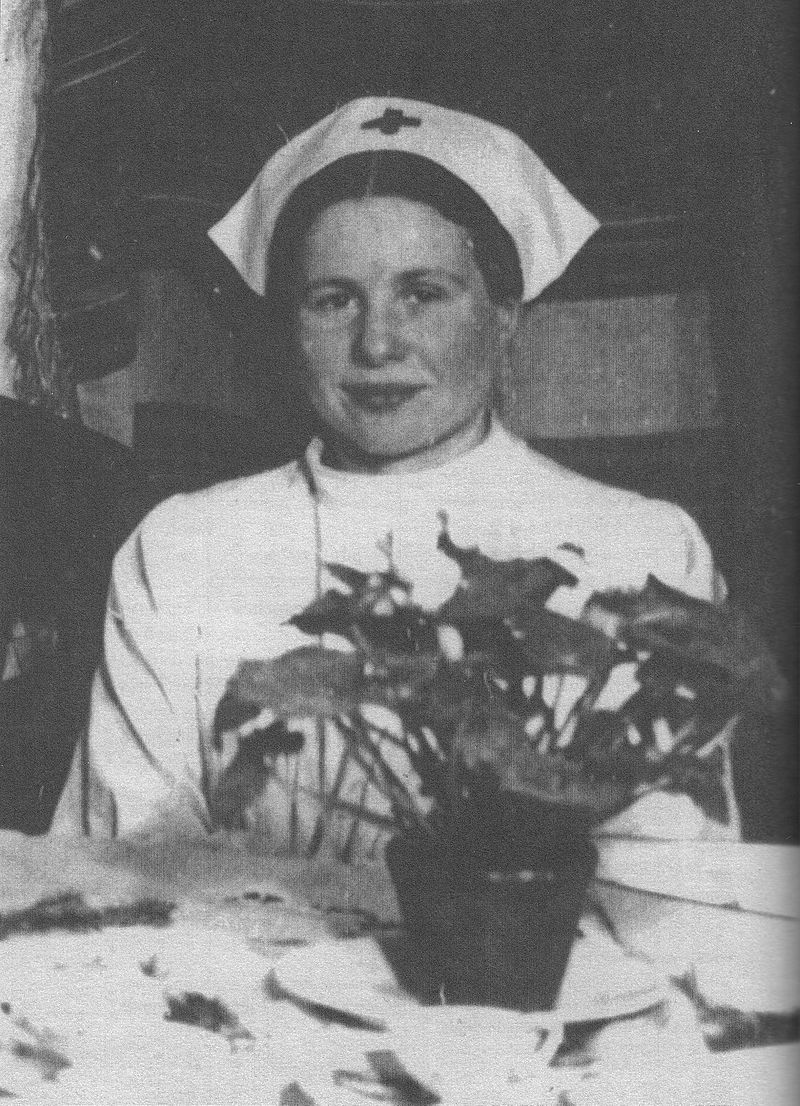
Post-War Challenges and Later Years
- Sendler had a key impact on the establishment of the Warsaw Children's Home. She was a member of the Polish Workers' Party and later the Polish United Workers' Party, which she joined in 1947.
- She participated in multiple social work initiatives, such as aiding adolescent sex workers in post-war Warsaw to reintegrate into society, establishing orphanages and support facilities for children, families and the elderly, and founding a centre for sex workers in Henryków.
- She requested Teresa Körner, who was currently in Israel, to help her immigrate to Israel with Jewish children who were in danger in Poland. Körner disapproved of Sendler's decision. In 1967, Sendler requested a disability pension after suffering from anxiety disorder and heart conditions. From 1962, she worked as deputy director in several Warsaw trade medical schools, but her unfavourable health led to her removal from the role of vice principal at the school. She worked at the same school from the autumn of 1967 until her retirement in 1983, serving as a teacher, manager of teacher workshops, and librarian.
- In 1980, Sendler became a member of the Solidarity movement and resided in Warsaw until her death. She passed away on 12 May 2008, at the age of 98, and was laid to rest in Warsaw's Powązki Cemetery.
- Sendler received many awards for her humanitarian efforts, including:
- Honoured by Yad Vashem in 1965 as one of the Polish Religious Among the Nations
- Made an honorary citizen of Israel in 1991
- Received the Commander's Cross of the Order of Polonia Restituta in 1996 and a higher version in 2001
- Pope John Paul II commended her work during warfare in 2003
- Irena Sendler's Award 'For Repairing the World', created in 2006
- Recognition from Senate of Poland and US Congress in 2007
- Posthumously awarded Humanitarian of the Year by The Sister Rose Thering Endowment and Audrey Hepburn Humanitarian Award in 2009
- Memorial plaques installed in Warsaw and Lowell Milken Centre for Unsung Heroes museum in 2016
Image Sources
- https://upload.wikimedia.org/wikipedia/commons/thumb/2/2f/Irena_Sendlerowa_1942.jpg/800px-Irena_Sendlerowa_1942.jpg
- https://upload.wikimedia.org/wikipedia/commons/b/bb/Bundesarchiv_Bild_101I-134-0791-29A%2C_Polen%2C_Ghetto_Warschau%2C_Ghettomauer.jpg
- https://upload.wikimedia.org/wikipedia/commons/thumb/d/de/Irena_Sendlerowa_24_grudnia_1944.jpg/800px-Irena_Sendlerowa_24_grudnia_1944.jpg
Frequently Asked Questions
- Who was Irena Sendler?
Irena Sendler was a Polish social worker renowned for her courageous actions during World War II. She saved over 2,500 Jewish children from the Warsaw Ghetto.
- What did Irena Sendler do during World War II?
Sendler, along with her network of colleagues, smuggled Jewish children out of the Warsaw Ghetto, providing them with false identities and sheltering them in convents, orphanages, and with sympathetic families.
- How did Irena Sendler manage to save so many children?
Sendler utilised various methods, such as hiding children in ambulances, using underground tunnels, and creating false documents to smuggle children out of the ghetto. She also coordinated with families and organisations willing to take in Jewish children.
